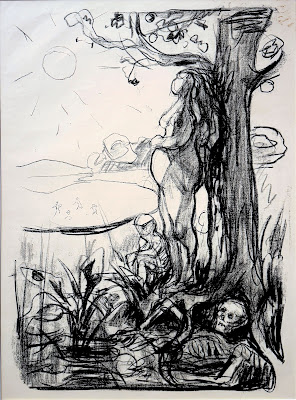The title of this blog is my English translation of
Lebenslandschaft,
the motto in German the curator had given
Edvard Munch's paintings exhibited in Potsdam's Barberini Museum. In contrast, the
English subtitle is Trembling Earth.

|
|
Our coach on Alter Markt (Old Market) in front of St. Nicholas
Church
|

|
|
The Museum Barberini is just opposite St. Nicholas Church
|
Before we started the visit to the exhibition, we had an excellent introduction.
An art expert explored Munch's inner linking between the landscape and the
people living within.
He started with The Yellow Trunk (1912), which lies cut between living spruce
trees whose violet bark has a structure resembling cells. Munch thus
represents death and life, celebrates the growth of the trees, and hints at
the destruction of the Norwegian forests. Still, yellow is Munch's color of
life.

|
| ©Wikipedia |
Let me become chronological. One of Munch's first and most well-known paintings
is The Scream (1893), which was not displayed at the exhibition.

|
|
The Scream 1895 (Click to enlarge)
|
Instead, we saw a lithograph with the German title
Das Geschrei (The
Clamor or The Screaming), which means it is not a scream of a few seconds but
rather continuous. Munch writes about an experience that inspired him in German,
"
Ich fühlte das grosse Geschrei durch die Natur
(I felt a tremendous, endless cry go through nature.)"
The figure is part of the agitated landscape. It covers its ears to block out
the scream - but it does not succeed: nature's pain seizes it.
Was Munch inspired by St. Paul's letter to the Romans?
We know that the whole creation has been groaning in labor pains until now,
and not only the creation, but we ourselves, who have the first fruits of
the Spirit, groan inwardly while we wait for adoption, the redemption of our
bodies. For in hope, we were saved [Romans 8,22-25:22].

|
|
Metabolism (Life and Death) 1896
|
The scream raises questions about humankind's interaction with nature. On the
other side of Munch's spectrum is the sun, the elemental force, energy provider,
and the foundation of all life on Earth. Under the sun's influence, new life is
fertilized out of a decomposing corpse and growing in the woman's womb.

|
|
Metabolism 1916
|
Munch took up the topic more dramatically in later years. A corps is
fertilizing seedlings showing human faces.

|
|
Funeral March 1897
|
And again, the sun. Naked bodies reach for the sky. A mountain of people
lifts a coffin towards the light of life.

|
|
Fertility 1900
|
And now some color. Instead with an apple, is the woman tempting the man with
her cherries? I leave further interpretations to the imagination of my
readers. Throughout his life, Munch had strange relationships with women.

|
|
Self-portrait with a model on the beach at Warnemünde 1907
|

|
|
Bathing Men 1908
|
On the German Baltic Sea beach - still an Eldorado of nude culture today -
Munch found many male motifs.

|
|
Self-portrait against a Blue Sky 1908
|
It looks like, in 1908, Edvard was at peace with himself. He stands upright
and is surrounded by nature. His yellow vest reflects the sun's rays. However,
we learned that
Munch was in a fragile psychological state regarding sunlight as a source
of health and rejuvenation.
What else?

|
|
Children in the Woods 1902
|
Woods, especially Norway's dense and dark ones, were one of Munch's favorite
motifs. Just as the woods is
a leitmotif in German fairy tales with its
dwarves and witches, Munch's forest partners are children, trolls, and lovers.

|
|
Towards the Forest 1915
|
Munch's comment: "A forest is a place where love either can break or become
intimacy."

|
|
The Fairy-Tale Forest 1929
|
Let us read the description of the above painting at the museum:
Three children enter a bright clearing. Towering spruce trees all around and
the dark sky create a claustrophobic atmosphere. The poisonous green color
reinforces the eerie feeling, as does the anthroposophical shape of the tree
on the right. Its branches resemble the open mouth of a troll that seems to be
approaching the children.

|
|
Self-Portrait 1940
|
Edvard Munch is 77. He presents himself as an unhappy, aging man. The world is
cold, and snow lies in the garden. Did he anticipate the German invasion of Norway on
April 9, or had it already occurred? Munch died in January 1944.
*

















No comments:
Post a Comment